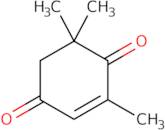2,6,6-Trimethyl-2-clclohexen-1,4-dione
CAS : 1125-21-9
Ref. 3D-FT145083
| 100mg | Arrêté | ||
| 250mg | Arrêté | ||
| 500mg | Arrêté |
Informations sur le produit
- 3,5,5-Trimethyl-2-clclohexen 1,4-dione4-Oxoisophorone
- 2,2,6-Trimethyl-2-Cyclohexene-1,4-Dione (Cetoisophorone)
- 2,2,6-Trimethylcyclohex-2-En-1,4-Dione (4-Oxo-Isophorone)
- 2,6,6-Trimethyl-2-Cyclohexene-1,4-Dione
- 2,6,6-Trimethyl-2-Cyclohexene-4-Dione
- 2,6,6-Trimethyl-2-cyclohexen-1,4-dione
- 2,6,6-Trimethylcyclohex-
- 2,6,6-Trimethylcyclohex-2-Ene
- 2,6,6-Trimethylcyclohex-2-ene-1,4-dione
- 2-Cyclohexen-1,4-dione, 2,6,6-trimethyl
- Voir d'autres synonymes
- 2-Cyclohexene-1,4-dione, 2,6,6-trimethyl-
- 3,5,5-Trimethyl-2-cyclohexene-1,4-dione
- 4-Ketoisophorone
- 4-Oxo-α-isophorone
- 6-Oxoisophorone
- Ketoisophorone
- Oxoisophorone
- Oxopholone
- Oxophorone
- keto-Isophorone
- 2,6,6-Trimethy-2-cyclohexene-1,4-dione (4-oxoisophorone)
- 4-Oxoisophorone
2,6,6-Trimethyl-2-clclohexen-1,4-dione is an alkanoic acid that is synthesized by reacting copper chloride with a hydroxyl group. The reaction mechanism of this compound is not well understood. This alkanoic acid has been shown to react with nitrogen atoms in biological studies, and it also inhibits the activity of enzymes such as ketoisophorone oxidase and aminopeptidase. 2,6,6-Trimethyl-2-clclohexen-1,4-dione has been observed to act as an oxidation catalyst and a redox potential (E°) catalyst. It has been shown to suppress the growth of fungi on plant materials during solid phase microextraction for structural analysis.





